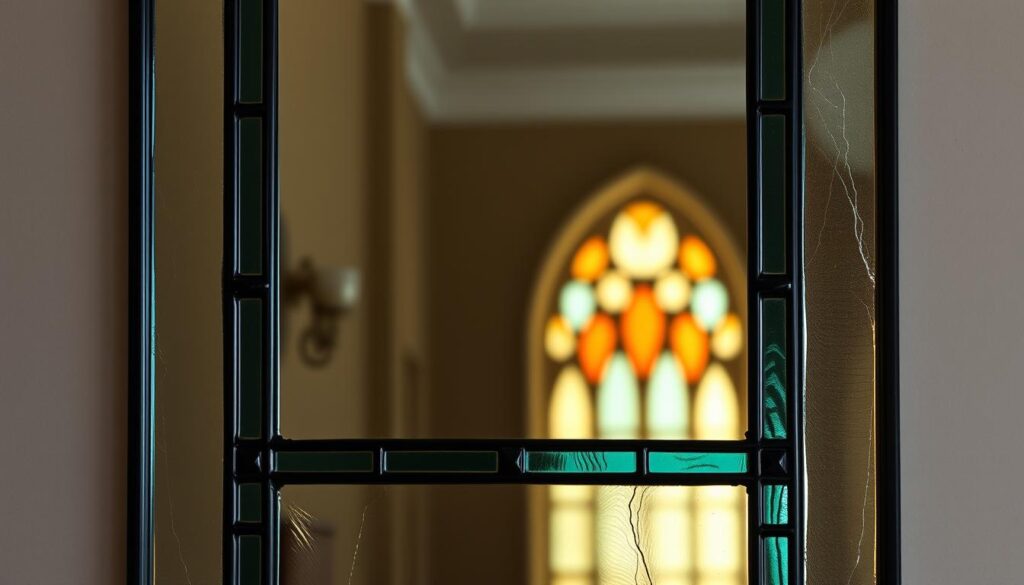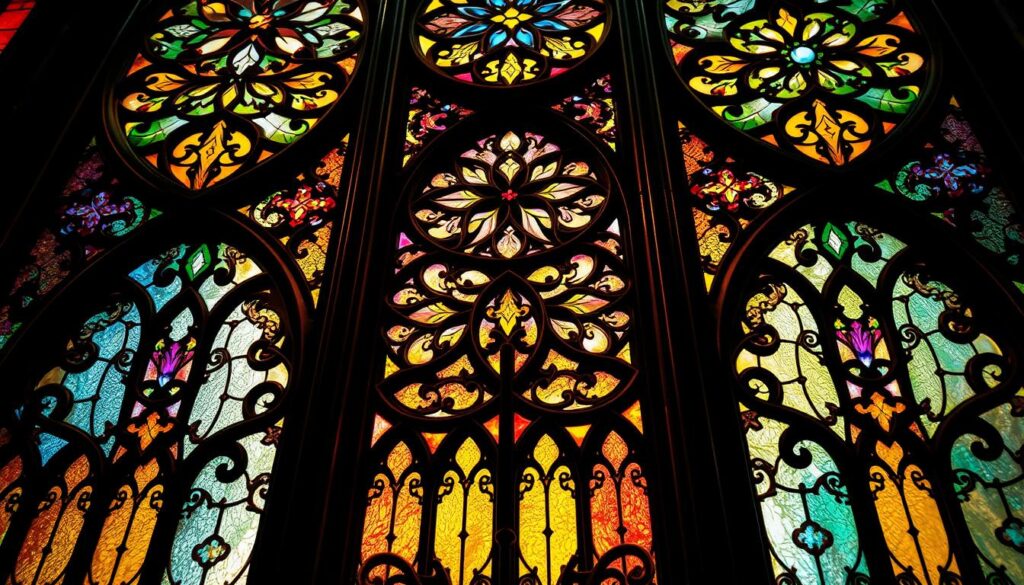Discover the art of transforming stained glass into breathtaking works of art by incorporating bevels and jewels. Noted artist Ed Sibbett, Jr.’s unique designs showcase the beauty of beveled glass and specially cut “jewels” that capture and refract light.
By adding these elements, you can create stunning visual effects that elevate your projects to extraordinary heights. The facets cut into the glass make light dance, mimicking the inner fire of an expertly cut precious gem. This comprehensive guide will walk you through selecting, designing with, and incorporating these elements into your designs, making it perfect for both beginners and experienced crafters looking to enhance their stained glass creations.
Understanding Bevels and Jewels in Stained Glass
Understanding bevels and jewels is crucial for taking your stained glass creations to the next level. These elements are not just decorative; they significantly enhance the visual appeal of your work.
What Are Bevels and Jewels?
Bevels and jewels are specially cut glass pieces that capture and refract light. Bevels are pieces of clear glass with angled edges that act as prisms, creating rainbow effects. Jewels, on the other hand, are small, thick pieces of colored glass that are faceted or molded to resemble gemstones, concentrating light and adding depth to your stained glass art.
How They Transform Traditional Stained Glass
The incorporation of bevels and jewels transforms traditional stained glass by adding dimension and light play. They create focal points that draw the viewer’s eye, making your artwork more engaging. The manufacturing process involves cutting, polishing, and preparing these glass pieces for use in stained glass work, a technique that has evolved from architectural applications to decorative art.
The Magic of Light Refraction
When light passes through beveled edges and faceted jewels, it creates a stunning visual display. The facets cut into the glass make light dance, producing an effect that is both mesmerizing and beautiful.
Creating Prismatic Effects
The scientific principle behind this phenomenon is light refraction. As light passes through the beveled edges and faceted jewels, it is refracted, or bent, creating a prismatic effect. This results in dynamic, ever-changing displays that bring stained glass pieces to life throughout the day.

Mimicking Precious Gems
The visual effects of jewels in stained glass are comparable to those of natural gemstones. The thickness and faceting of cut glass create similar optical properties, giving the appearance of an expertly cut gem. By strategically placing bevels and jewels in relation to light sources, you can maximize these effects.
Types of Bevels and Jewels Available
To create truly captivating stained glass pieces, understanding the types of bevels and jewels available is crucial. Bevels and jewels are not just decorative elements; they are essential components that can transform a simple stained glass design into a masterpiece.
The variety of bevels and jewels available in the market allows artists to experiment with different patterns and designs. You can find pre-made bevels in various shapes such as rectangular, square, oval, and circular, which can be used as clusters, corners, borders, or centerpieces in your stained glass projects.
Beveled Glass Varieties
Beveled glass comes in a range of shapes and sizes, from simple geometric forms to intricate custom designs. You can choose from various dimensions and thicknesses to suit your project’s requirements. Whether you’re working on a traditional or contemporary stained glass piece, beveled glass can add a touch of sophistication.
Jewel Glass Options
Jewel glass offers a dazzling array of colors, sizes, and shapes. You can select from different faceting patterns to achieve the desired level of sparkle and shine. Specialty jewels like glue-chip bevels, textured jewels, and hand-cut custom pieces provide endless possibilities for creativity in your stained glass designs.
You can source quality bevels and jewels from specialty suppliers, craft stores, and online marketplaces. Prices vary depending on the complexity, size, and material of the bevels or jewels.
Popular Design Styles Using Bevels and Jewels
Incorporating bevels and jewels into stained glass patterns has opened up new possibilities for artists, allowing them to create intricate stained glass patterns with various motifs.
Victorian and Art Nouveau Motifs
The rich tradition of Victorian stained glass designs is characterized by elaborate beveled borders and jewel accents, often featuring floral and geometric victorian motifs. In contrast, Art Nouveau motifs incorporate flowing lines and organic forms, enhanced by the strategic placement of jewels.
Contemporary Applications
Contemporary design approaches blend minimalist aesthetics with statement bevels and jewels, creating a unique visual appeal. Modern artists are reimagining traditional patterns by incorporating bevels and jewels in unexpected ways, resulting in innovative designs.
| Design Style | Characteristics | Bevels and Jewels Usage |
|---|---|---|
| Victorian | Elaborate, floral, geometric | Beveled borders, jewel accents |
| Art Nouveau | Flowing lines, organic forms | Strategic jewel placement |
| Contemporary | Minimalist, statement pieces | Innovative bevel and jewel usage |
Incorporating Bevels and Jewels into Your Designs
The art of incorporating bevels and jewels into stained glass designs requires both creativity and technical skill. You can create one-of-a-kind patterns that are as easy to use as ordinary stained glass.
Planning Your Pattern
When planning a stained glass project that includes bevels and jewels, consider scale, balance, and focal points. You can either adapt existing stained glass patterns to accommodate these elements or design custom patterns around them.
Integration Techniques
To integrate bevels and jewels, you’ll need to cut surrounding glass to fit precisely around these pre-made elements. Modifying your foiling or leading techniques is also necessary to accommodate their thicker edges. For larger or heavier pieces, ensure you provide adequate structural support.
| Technique | Description | Consideration |
|---|---|---|
| Cutting Glass | Precise cutting around bevels and jewels | Accuracy is key |
| Foiling/Leading | Modifying techniques for thicker edges | Requires practice |
| Structural Support | Ensuring stability for heavier pieces | Crucial for larger designs |

Project Ideas for Beginners and Experts
By using bevels and jewels, you can create stained glass pieces that are not only functional but also decorative and eye-catching. Whether you’re a beginner or an expert, there are numerous project ideas to explore.
Door and Window Panels
Enhance your home’s aesthetic with custom door and window panels featuring bevels and jewels. These panels can add a touch of elegance and sophistication to any room.
Decorative Boxes and Mobiles
For intermediate crafters, decorative boxes with jeweled lids and hanging mobiles showcasing light refraction are excellent projects. These pieces can be both functional and decorative.
Mirrors and Light Catchers

Advanced crafters can explore complex designs like full door panels and large windows that combine multiple bevels and jewels. Mirrors with beveled borders are also a great way to enhance both functionality and aesthetics.
Essential Tools and Materials
To successfully integrate bevels and jewels into your stained glass projects, you’ll need to gather the necessary materials and tools.
Basic Supply List
When working with bevels and jewels, your basic supply list should include quality glass cutters, running pliers, and grozing pliers. These tools are crucial for handling and cutting glass around pre-made bevels.
You’ll also need lead came, copper foil, and solder that are compatible with beveled elements. Specialty adhesives and reinforcement materials are necessary for securing heavier bevels and jewels.
Where to Source Quality Materials
You can source quality materials from specialty suppliers, including online resources and local craft supply stores. For unique or vintage bevels, consider salvage options.
Ensure that the materials you choose are easy to use and suitable for stained glass crafting.
Troubleshooting Common Challenges
As you elevate your stained glass art with bevels and jewels, you’ll likely face common challenges that can be addressed with the right techniques. Incorporating bevels and jewels into your stained glass patterns can be straightforward, but issues may arise that require some problem-solving skills.
Working with Irregular Shapes
One common challenge is working with irregular or non-standard shaped bevels that don’t fit neatly into your glass pattern. To overcome this, you can adapt your design to accommodate these unique shapes or use specialized cutting tools to adjust the bevels to fit your pattern.
Securing Bevels and Jewels Properly
Another issue is securing heavier bevels to prevent sagging or separation over time. To address this, ensure that you use a strong adhesive and provide additional support where necessary. Properly securing your bevels and jewels will help maintain the integrity of your glass artwork and ensure it remains durable.
Conclusion: Future-Proofing Your Stained Glass Craft
Mastering bevels and jewels is key to unlocking the full potential of your stained glass craft. By incorporating these elements, you can elevate your projects and expand your creative possibilities. The Bevels and Jewels Stained Glass Pattern Book offers 83 designs to inspire your work, featuring floral, geometric, and Art Nouveau motifs.
As you continue to explore and experiment with bevels and jewels, you’ll discover new ways to craft unique pieces. Consider exploring resources like online tutorials, workshops, and communities dedicated to advanced stained glass techniques to further enhance your skills. With a glass pattern book and practice, you’ll be well on your way to creating stunning projects that showcase your artistic voice.
